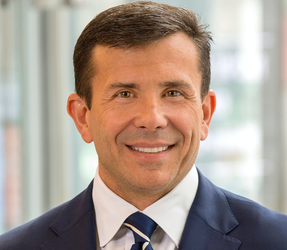Alliance Discussion with John Crowley: An Innovative, Patient-Centered Approach to Rare Diseases

On May 2, we were joined by John Crowley, Chairman and CEO of Amicus Therapeutics, for an inspiring alliance discussion focused on his personal journey with rare disease research, developing novel treatments, centering patient advocacy, and overcoming innovation barriers. John has had a positive influence on rare disease research over the last two decades and it was enlightening to hear his viewpoint on the future for this field. Some highlights:
On getting involved with rare disease research:
“Our family’s journey is very similar to many families in the world of health care. It began 25 years ago, when our then 15-month-old daughter, Megan, was diagnosed with a rare form of muscular dystrophy known as Pompe disease. Up until that point, Megan was seemingly healthy. We went on that diagnostic odyssey, from pediatrician to eventually getting this diagnosis. We had never heard of Pompe disease; there’s no history in our family. My wife Eileen and I are silent carriers, like we all are for any number of disorders. We were also told that our then 7-day-old son, Patrick, had a 1 in 4 chance of having the disease as well. Then, there was very little research and very little known about [Pompe] and many other rare diseases. We were told to enjoy the time we had, that it might only be a couple of years for the children, and that launched us into the world of medicine.”
“I’m not a researcher, scientist, or even a physician; I’m an impassioned parent. Ultimately, we were successful – with an enormous number of people helping along the way – in developing a first-generation therapy for Pompe that saved [Megan and Patrick’s] lives. I think it’s important for all of us to remember that there are now nearly 8,000 known rare diseases, with the vast majority (>95%) having no treatments or therapeutic options.”
On Amicus being a patient-centered company:
“At Amicus, I want [patient advocacy] to be core to who we are. We named a Chief Patient Advocate, a C-suite level executive at Amicus. We’re thinking about what’s meaningful to people living with a disease; we may scientifically or medically have a point of view, but understanding the journey, the day-to-day life experience of somebody living with a health challenge, is incredibly important. That means a higher likelihood of success through clinical studies and getting to more patients more quickly when our medicines are approved. We have a policy at Amicus that every interaction we have with a regulatory body must include a patient representative from outside of the company — we begin every clinical meeting with the FDA with a patient speaking.”
On overcoming barriers to accessing rare disease treatment:
“[We need] an ecosystem where medicines are fairly priced and universally accessible. Janet Woodcock at FDA had a great speech a number of years ago and she said, ‘Until a homeless person has access to the state-of-the-art CAR-T therapies, we will not have succeeded.’ I’ve always been a proponent, like many of us in the industry, of ensuring universal access and looking at something like copays — I believe we should revisit the entire notion of copays in wide therapeutic areas. People living with [cancer or rare diseases] have enough skin in the game, they don’t need to pay a copay too.”
On the progress made in rare disease research:
“There has never been a more exciting time to be in our industry. 25 years ago, I had to travel the world to find two, maybe three doctors who knew anything about [Pompe disease], now we’ve got 12+ companies working just on Pompe. We finally have approved medicines in Duchenne muscular dystrophy; look at the range of technologies that we have coming — small molecules, large molecules, gene therapies, gene editing — that’s going to transform human health.”
On the future of rare disease treatments:
“Rare diseases are not monolithic. We’re going to get to the point where we realize for each disease — for each individual within that disease — we need a custom-tailored approach. Given that there’s this interpatient variability, the heterogeneity of diseases, even though there may be common biology or pathophysiology, [we need] to think of each [individual] as an N=1 within those diseases.”




